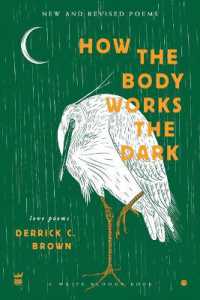- ホーム
- > 洋書
- > 英文書
- > History / World
Full Description
Between 58 and 51 BC Julius Caesar conquered Gaul. He campaigned across much of present day France and the Low Countries, crossed the Rhine to Germany, and sailed the Channel to invade Britain. In doing this he achieved immense personal wealth and glory and the loyalty of a battle-hardened army of veterans. Caesar's eventual return to Rome began with the crossing of the Rubicon which started a bloody civil war from which he emerged victorious and as dictator.
Roman historians have little to say on the consequences of the war on the Iron Age communities of north-west Europe. Their story is told instead by archaeology and numismatics. Huge numbers were involved in the war, at a vast cost in people and wealth. In the aftermath, leaders sympathetic to Rome were installed and sometimes whole peoples were resettled. The diplomatic relations created at this time directly affected the eventual incorporation of these peoples into the Roman Empire.
This book presents the latest archaeological research on the Battle for Gaul and its aftermath. Based on an acclaimed 2017 conference, it is the first Europe-wide overview and much of the research is published here in English for the first time. After an introduction to recent trends in historical studies, thematic studies and regional surveys analyse the archaeological and numismatic evidence from across north-west Europe. Comparative evidence for the Roman conquest of Spain is also examined, along with the fundamental role that the study of the Battle for Gaul played in shaping the development of Iron Age archaeology. Written by leading international experts, this book will be of interest to archaeologists, numismatists, ancient historians and military historians.
Contents
List of figures
List of tables
List of contributors
Introduction
Andrew P. Fitzpatrick and Colin Haselgrove
1. Scylla, Caesar and Charybdis: (Mis)readings of the Gallic War
Christopher B. Krebs
2. The Gallic Wars in Roman history
Greg Woolf
3. The Gauls on the eve of the Roman conquest
Ian Ralston
4. The Sertorian Wars in the conquest of Hispania: From data to archaeological assessment
Ángel Morillo and Feliciana Sala-Sellés
5. 58 BC: The Helvetii, from the Swiss plateau to Bibracte... and back
Gilbert Kaenel
6. Recent archaeological research on Roman military engineering works of the Gallic War
Michel Reddé
7. Caesar's conquest and the archaeology of mass violence in the Germanic frontier zone
Nico Roymans
8. Caesar's landing sites in Britain and Gaul in 55 and 54 BC: Critical places, natural places
Andrew P. Fitzpatrick
9. Gauls under siege: Defending against Rome
Sophie Krausz
10. Fighting for Caesar: The archaeology and history of Gallic auxiliaries in the 2nd-1st centuries BC
Lionel Pernet
11. The Hermeskeil fortress: New light on the Caesarian conquest of eastern Belgic Gaul and its aftermath
Sabine Hornung
12. Archaeology of the Roman Civil Wars: The destruction of Puig Ciutat (Catalonia, Spain) and Caesar's campaign in Ilerda (49 BC)
Àngels Pujol, Manuel Fernández-Götz, Roger Sala, Carles Padrós, Eduard Ble, Robert Tamba and Xavier Rubio-Campillo
13. The Gallic War in the chronology of Iron Age coinage
Colin Haselgrove
14. The island of Jersey: Focus of resistance or field of last resort?
Philip de Jersey
15. The second battle of Alesia: The 19th-century investigations at Alise-Sainte-Reine and international recognition of the Gallic period of the late Iron Age
Laurent Olivier








